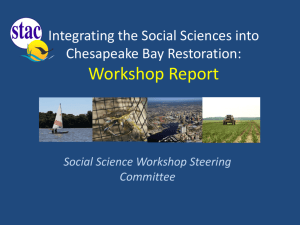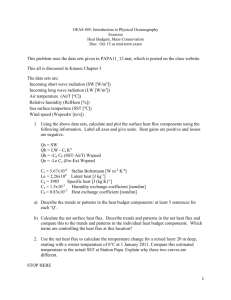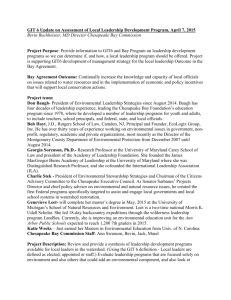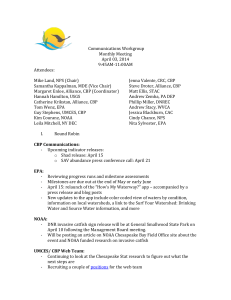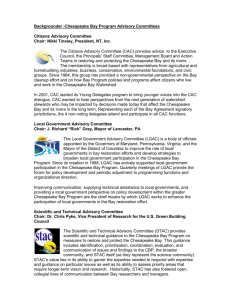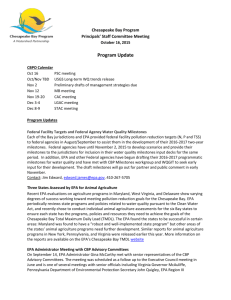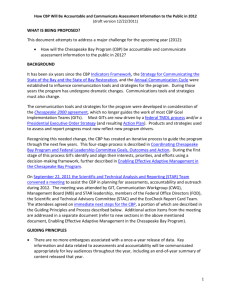Communications workgroup minutes
advertisement
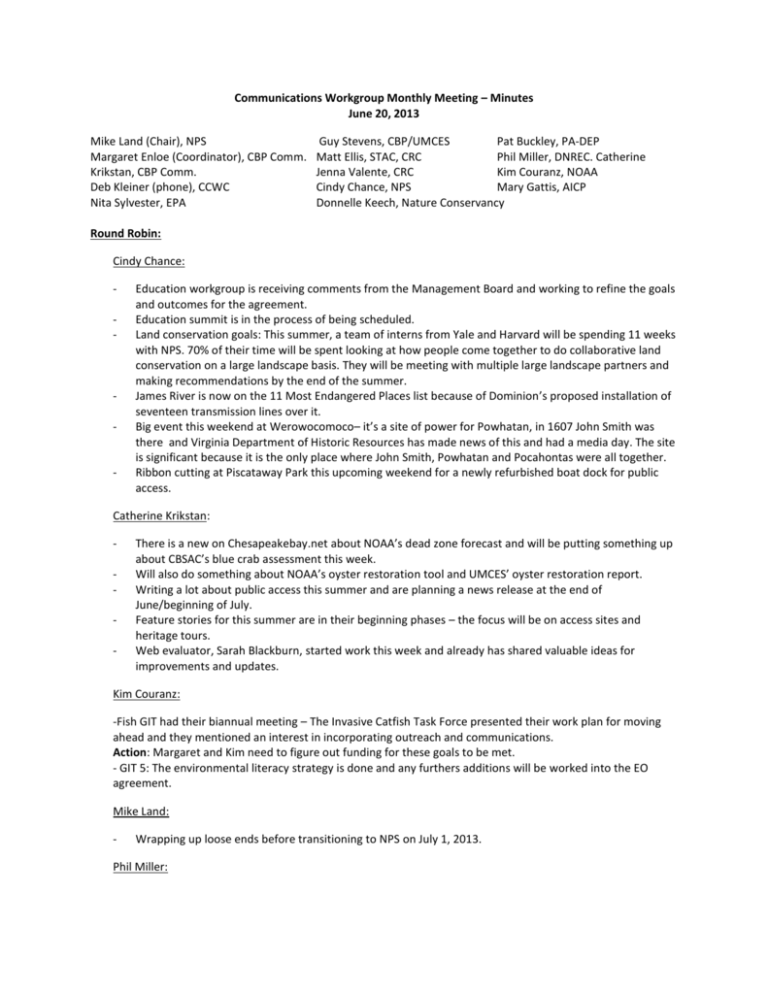
Communications Workgroup Monthly Meeting – Minutes June 20, 2013 Mike Land (Chair), NPS Margaret Enloe (Coordinator), CBP Comm. Krikstan, CBP Comm. Deb Kleiner (phone), CCWC Nita Sylvester, EPA Guy Stevens, CBP/UMCES Pat Buckley, PA-DEP Matt Ellis, STAC, CRC Phil Miller, DNREC. Catherine Jenna Valente, CRC Kim Couranz, NOAA Cindy Chance, NPS Mary Gattis, AICP Donnelle Keech, Nature Conservancy Round Robin: Cindy Chance: - - - Education workgroup is receiving comments from the Management Board and working to refine the goals and outcomes for the agreement. Education summit is in the process of being scheduled. Land conservation goals: This summer, a team of interns from Yale and Harvard will be spending 11 weeks with NPS. 70% of their time will be spent looking at how people come together to do collaborative land conservation on a large landscape basis. They will be meeting with multiple large landscape partners and making recommendations by the end of the summer. James River is now on the 11 Most Endangered Places list because of Dominion’s proposed installation of seventeen transmission lines over it. Big event this weekend at Werowocomoco– it’s a site of power for Powhatan, in 1607 John Smith was there and Virginia Department of Historic Resources has made news of this and had a media day. The site is significant because it is the only place where John Smith, Powhatan and Pocahontas were all together. Ribbon cutting at Piscataway Park this upcoming weekend for a newly refurbished boat dock for public access. Catherine Krikstan: - There is a new on Chesapeakebay.net about NOAA’s dead zone forecast and will be putting something up about CBSAC’s blue crab assessment this week. Will also do something about NOAA’s oyster restoration tool and UMCES’ oyster restoration report. Writing a lot about public access this summer and are planning a news release at the end of June/beginning of July. Feature stories for this summer are in their beginning phases – the focus will be on access sites and heritage tours. Web evaluator, Sarah Blackburn, started work this week and already has shared valuable ideas for improvements and updates. Kim Couranz: -Fish GIT had their biannual meeting – The Invasive Catfish Task Force presented their work plan for moving ahead and they mentioned an interest in incorporating outreach and communications. Action: Margaret and Kim need to figure out funding for these goals to be met. - GIT 5: The environmental literacy strategy is done and any furthers additions will be worked into the EO agreement. Mike Land: - Wrapping up loose ends before transitioning to NPS on July 1, 2013. Phil Miller: - - -Recently had a schoolyard habitat celebration in Seaford about a few projects that were funded through the Chesapeake Bay Implementation Grant. Looking into using recreation to raise awareness about water quality issues and to connect people to their waterways. In the beginning phases of planning a new event that will get people out on the water. Thinking a kayak race, a paddling expedition and/or a series of kayak clean ups would be a good way to get people out and connected to their natural resources. Currently looking for stretches of streams and rivers that could benefit from a cleanup, suggestions are welcome. Partnering with Delaware Nature Society and Dogfish Head Brewery will be sponsoring the event. Donnelle Keech: - -GIT 4 – Maintaining Healthy Watersheds – members and leadership have been working on finalizing goals, objectives and a work plan for the coming year. - GIT 4’s communications workgroup has been focusing on developing sessions for Chesapeake Bay Watershed Forum. - Earlier this month The Chesapeake Bay Commission released a white paper that focuses on policy recommendations for crediting conservation under the TMDL. Contact Donnelle if you are interested in finding a copy. Action: Donnelle, please send Margaret a copy For anyone that applied for panels at the Watershed Forum, you should be hearing sometime in the next week or about whether your proposal has been accepted or not. Deb Kleiner: - The Choose Clean Water Conference in Baltimore was very successful. Nearly 300 people were in attendance. Working with Chesapeake Bay Foundation to do a mid-milestone analysis for tracking the progress about how restoration efforts are going. Expected release date is July 8th. Matt Ellis: - - Workshop report updates: Environmental Literacy. – It’s overdue but was sent to STAC members for comment on June 14th and the final review is being sent to Kevin Sellner this week in hopes to that an embargoed copy will be sent to CBP next week with the final report being published after that (the first week of July). Sustainable Wastewater – Embargoed copy will come the same week as Environmental Literacy Report. Lag Times Report- Almost in draft form. It has not yet been sent to STAC members but will be after the draft is finished. Coastal Habitats- Has a due date of July 17th and is still in progress. M32 Multiple Management Models- Has an outline drafted for it and is in its beginning phases Nutrient Trading Workshop- Last report being worked on. It is currently in outline form. Executive Council/30th Year Celebration: - First planning team meeting was last week – spoke about logistics not details yet. Went on site visits two weeks ago to the National Arboretum, House of Sweden, and George Mason University. Planning team decided on functionality rather than legacy and decided with the Arboretum as their number one choice. GIT 6 is still working on drafting the agreement and getting the language right. There are some concerns about GITs getting too attached to their technical language where it could use the Communications Workgroup’s touch to create flow and a story line. - - - Very concerned about stakeholder input period and how we are going to take input in – Communications Workgroup is charged with figuring that strategy out. Communications Workgroup can help by spreading word of mouth and making sure everyone in the Bay Program is aware of the comment period. Action: Samantha, Mike Margaret need to meet to figure out how to help expand awareness of the agreement. Communications Workgroup has been tasked with figuring out how to move ahead and how to handle public comment. GIT 6 will handle how to respond to comments. Mary Gattis – Nick made it clear that the goal teams should not be wedded to the language but worry more about the content. Mike Land- It sounds like a drafting committee will form to handle the wording of the agreement. Mary Gattis- Communications Workgroup could lay out a schedule for the time needed to review and edit a draft so we can have a more realistic schedule to work on editing it. Concerned about the structure of the whole agreement process because there is no schedule at this point. Who is on the drafting team? When will it be formed? Something that we can pressure management about. When will no more outcomes be allowed to be submitted? Executive Council members who have to sign this agreement need at least three weeks to look over the document before they can sign it, so the document needs to be final by the second week in September at the latest. Action – Look at the schedule and make a recommendation for deadlines based on when everything needs to be done in time for the Executive Council members to be able to sign it. What is the strategy for the new agreement? Who is the audience? Those are questions that need to be answered before we can finalize this agreement. Is it written for public or for partners? The drafting committee should think about language that will provide clarity for both interested public and partners. Also need to decide how the comments from public are weighed against partners comments 30th celebration: - - - The celebration is not a Communications Workgroup product; the Alliance for the Chesapeake Bay is sponsoring it. Celebration is a communications/PR event – it’s a celebration of a generation of work and setting up for the future of the Bay Program and will focus on past success of CBP and what the world might be like if the Bay Program did not exist. Steve will be creating a 3-5 minute PSA that can be condensed and shown at future events that explain what the Bay Program is all about. A timeline will be created to show success stories in a cultural context over the past 30 years – Bay restoration movement and Bay Program will be linked. Want to reach out to long term stakeholders and ask for their top 5 moments in Bay history to create a printed product – idea is to be able to use these products after the event but this depends on if we can get the funding. A collection of success stories over the last 30 years will be compiled. Maybe CBF could contribute space to the 30th anniversary celebration? Video Intern: Video intern is a part time, unpaid position. We look to have one hired by next week. Lessons Learned: - The Lessons Learned document came out of a STAR meeting. It is a literature review about 30 or more case studies from around the Bay watershed. The anticipated release is in September of this year. It will be available via the IAN website. - - - - It might be best to wait for the release of the document to story about it on our website. Lessons learned will be highlighted in the Report to Congress which is a report that occurs every 5 years to inform congress about the efforts of the Bay clean up. Communications workgroup should look it over and decide if there is any of the content worthy of public attention. There might be some interest outside of managers and CBP staff because of the locations of some of these case studies. Individual states can highlight case studies of particular local interest Could be great for the farms in the case studies to use as marketing if they are a success story. Local government advisory committees could use this to identify best management practices. Development and implementation teams seem like they could use this to develop their strategies and taking a broader look at what is working and what is not. It inspires confidence in the whole process that we are learning as we go, we can use it combat skeptics. We will want to make local WIP teams and governments are aware of this as well because they aren’t always working on Bay restoration and might not know it exists and/or when it will be released. Action: Mike will reach out to Nick DiPasquale to learn more about stakeholder input in order to figure out what is feasible. Also, he will learn more about the drafting team process and timeline. Action Items for Communicating the Lessons Learned report: Already planned by Tom Wenz and Rich Batiuk: highlight some of the local case studies in the Report to Congress (Oct) Already planned by Margaret Enloe and Catherine Krikstan: news/blog post a ChesapeakeBay.net (Sept) Catherine Krikstan, working with Steve Droter and Jenna Valente: “Restoration Spotlights” story(ies), w/ video and/or pictures, for posting at ChesapeakeBay.net. Consider developing “Restoration Spotlights” that would be useful for LGAC to use with their constituents; another that would be useful to states to use with their WIP teams; and/or another that would be useful for promoting farms where successful best management practices were implemented (TBD) Mary Gattis: Inform LGAC members about the local case studies for them to share with their constituents (TBD)
